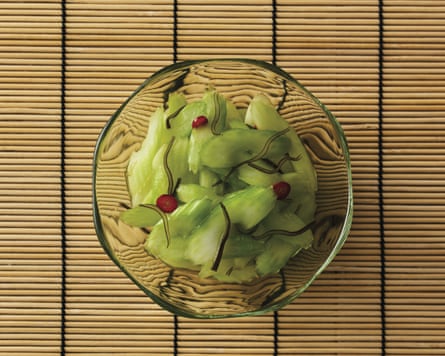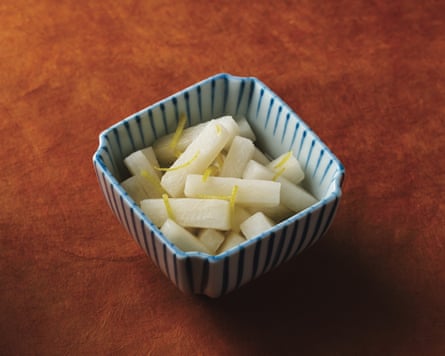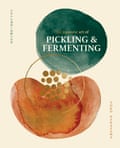I’ve been eating pickles made from different vegetables in various ways since I was little. Every meal included some kind of pickle on our table. I grew up in Japan and pickles were also included in bento boxes, whether it was homemade, an Ekiben from the station, or a convenience-store bento. If there aren’t any pickles on the table, I feel like something is missing.
Pink radish amazu zuke (sweet pickle), below, is a great way to brighten up your plate, and it’s incredibly easy to make. When preparing it, the radish initially loses its colour, which transfers into the pickling liquid. After a few days, the liquid turns the radish into a beautiful, vibrant pink.
I find the colour is perfect by the third day. You can keep it longer if you want but, interestingly, if you leave it too long the colour fades again.
Celery pickles also hold a special place in my heart. Celery is not a traditional Japanese vegetable, so I was pleasantly surprised to discover how delicious it can be when pickled in the Japanese style.
Since moving to Australia, where celery is readily available, I’ve started making celery asazuke (quick pickle) more often. The crunch makes this asazuke very fun. Fresh green celery with a hint of red chilli makes a great contrast on your plate too.
The chilli I use with the celery asazuke is not really for hotness – I can’t handle spicy food very well, but it does add a tiny kick and enhances the flavour. Serve these as a palate cleanser alongside rich food.
Finally, the yuzu daikon amazu zuke is one of my favourites. Aroma plays a crucial role in pickling, and the addition of yuzu in this pickle elevates the flavours.
At home, we have a large yuzu tree that produces an abundance of fruits: we use the green yuzu at the end of autumn and the bright-yellow ones throughout winter. With such a plentiful supply, we even make yuzu jam and put yuzu into the bathtub. We also grow plenty of daikon, which often features in our meals and pickles. The way you cut and prepare daikon can transform its texture, making it an incredibly versatile vegetable.
Pink radish amazu zuke – recipe
(Pictured above)
Pickling time: 3 days
150g red radishes, remove the leaves
4g sugar (2–3 % of radish weight without leaves)
60ml vinegar
If the radishes are large, cut them into bite-sized pieces. If they’re small, you can leave them whole. Depending on the size, I sometimes halve or quarter them.
Weigh the radishes to calculate the amount of sugar required.
Place the radishes in a sterilised jar. Sprinkle the sugar over the top, pop the lid on and shake the jar to evenly distribute the sugar.
Take the lid off and add the vinegar. Pop the lid back on tightly and turn the jar upside down and leave it in the refrigerator overnight.
The next day, return the jar to its original upright position so that the top radishes can now soak in the pickling liquid. You can flip the jar upside down as much as you like, or shake it – all of the radishes will be pickled after three days.
Store in the refrigerator for up to one month.
Celery asazuke – recipe

Pickling time: 10 minutes
200g celery stalks
½ red chilli
Pickling liquid
5–10g sugar
30ml vinegar
5cm square of dried kombu, cut into thin strips
5g salt
Carefully remove the hard strings from the celery, then diagonally cut the stalks into 1-1.5 cm slices. Remove the seeds from the chilli and finely slice it into rings.
Combine the celery, chilli, sugar, vinegar, kombu and salt in a bowl.
Use your fingers to gently massage the celery for one to two minutes, until you feel moisture begin to release.
Place a plate on top of the celery as a weight.
Allow the celery to rest in the refrigerator for at least 10 minutes before serving. If you can leave it until the next day it’s even better.
Store in a clean container in the refrigerator for up to 10 days.
Yuzu daikon amazu zuke – recipe

Pickling time: 1 hour
500g daikon
15g salt (3% of daikon weight)
1 yuzu, save the juice for the pickling liquid
Pickling liquid
60ml vinegar
Yuzu juice
20g sugar
Pinch of salt
Cut the daikon into 1cm × 4cm matchsticks.
Place the daikon pieces in a colander or bowl and sprinkle them with the salt to draw out excess moisture. Place a plate on top as a weight and allow the daikon to rest for 10 to 15 minutes.
Meanwhile, slice a strip or two of yuzu peel off the outer yellow part. Don’t include any pith as it is bitter. Finely slice the peel.

To make the pickling liquid, combine the ingredients in a bowl, mixing well until the sugar and salt have dissolved.
Using both hands, squeeze the water out of the daikon, then place it in a clean container or bowl with the yuzu peel. Pour the pickling liquid on top and place a plate on top as a weight.
Allow the pickles to rest in the refrigerator for at least one hour before serving.
Store in a clean container in the refrigerator for up to one week.
-
This is an edited extract from The Japanese Art of Pickling and Fermenting by Yoko Nakazawa, photography by Rochelle Eagle (Smith Street Books; $49.99)

 3 months ago
53
3 months ago
53

















































